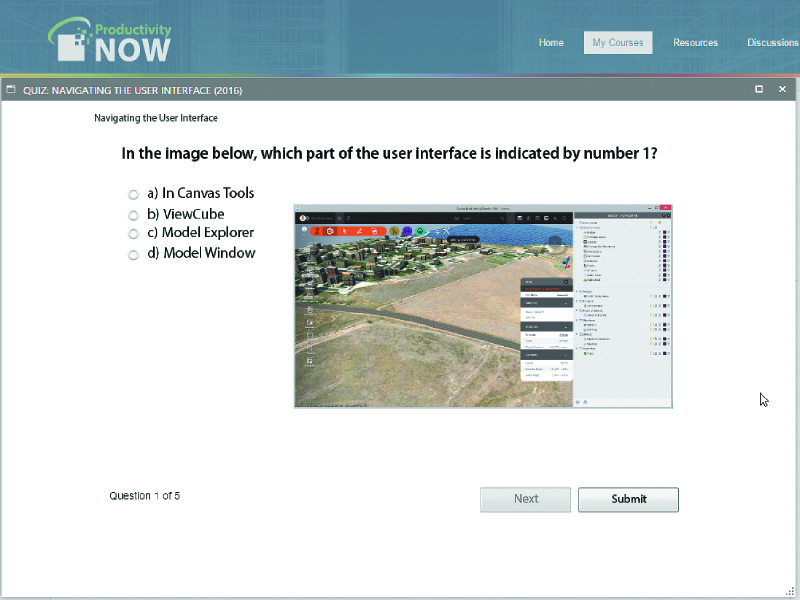By Michelle Rasmussen
Many companies are augmenting the traditional, classroom training offered to employees with self-paced, online learning courses. This type of learning offers compelling benefits to both employers and employees. It’s time geospatial companies joined in.
Business Benefits
From a business perspective, self-paced learning is powerful for three reasons: it increases employee engagement, lowers training costs, and improves employee productivity.
1
A great way to increase employee satisfaction and retain top performers. In a recently published research report, The Society for Human Resource Management found a gap between employees’ expectations about training and their satisfaction with what employers offer. For example, 42% of survey respondents said that job-specific training was very important, but only 25% were very satisfied with the job-specific training they receive. Similarly, 40% indicated that an organizationÕs overall commitment to professional development was very important, but only 25% were satisfied with what their employer offers.
In the surveying and civil engineering space, training and professional development is essential. In the U.S., civil engineers in many states must comply with mandatory professional development requirements to remain registered as a professional engineer. Offering self-paced learning courses can help employees meet those requirements and simultaneously improve employee engagement. Since self-paced learning offers a consistent training experience for all employees, it ensures that everyone has a high-quality training experience.
E-Learning lowers training costs
2
Makes training more economical. Self-paced, online learning can be done anywhere that employees have internet access. As a result, it’s a great way to cut down on training-related travel expenses. It’s also less disruptive to the business than traditional, classroom training. Employees can engage in coursework anytime, and learning can be done in small chunks, as time allows. That means that billable work on projects doesn’t have to be interrupted.
3
Keeps employees up to date with the latest software features. The software tools that support surveying, geospatial, and civil engineering work are constantly being improved. New features can streamline project work, but only if employees know how to use them. Self-paced learning is an effective way to do targeted training on new product functionality. When employees understand how to apply software to their work, user adoption increases, which in turn improves the return on software investments made by companies.
Employee Benefits
1
Highly flexible, which makes participation easy. All learners need is an internet connection. In addition, there’s no software to set up. Training time is focused on learning, not on getting ready to learn.
It’s more also flexible than classroom training. Employees can participate whenever it’s convenient for them, even after office hours or on weekends. Many eLearning courses are structured to allow learners to skip or test out of content that they already know. This ensures that course participants aren’t wasting valuable time and can make the most out of their learning experience.
2
Learners can consume content in small, manageable chunks, as time allows. Not only does this offer greater flexibility to employees, it also can improve learning retention. People often retain content better when they have time to absorb concepts between lessons.
3
The benefits continue after the initial interaction with the course because the courseware continues to be a great reference tool when questions arise on the job. It’s easy to refer back to concepts in specific modules. As Harvard Business Review has noted, one of the advantages of eLearning is that it’s “a collection of interrelated learning nuggets,” and individuals can interact with them in whatever way is best suited to their needs.
What to Look For
1
Features that reinforce different learning styles. Some people do best when reading content, while others learn better when listening to a lecture or participating in hands-on activities. Look for learning solutions that convey information in ways that will appeal to diverse learning styles. For example, many eLearning options offer embedded video for mini-lectures and demonstrations, as well as hands-on lessons and downloadable reference materials.
2
Interactive features. Students learn more effectively when they interact with the content that is presented. A great way to facilitate this is through review questions and quizzes that reinforce key concepts.
3
Functionality that supports an incremental approach to learning. Self-paced learning is designed to be consumed based on employee availability; learners should be able to bookmark where they are in a course, so it’s easy to return later. Progress trackers are also helpful for signaling where a learner is in the course overall.
4
Documentation of completion. Transcript reports and certificates of completion are important documents for employees. They can be used to demonstrate professional development hours to HR or to outside organizations.
The next time that your employees need to get up to speed on a new software solution, new product features, or new approaches to projects, take a look at self-paced learning. It’s an option that increases employee productivity while minimizing the impact on the business.

